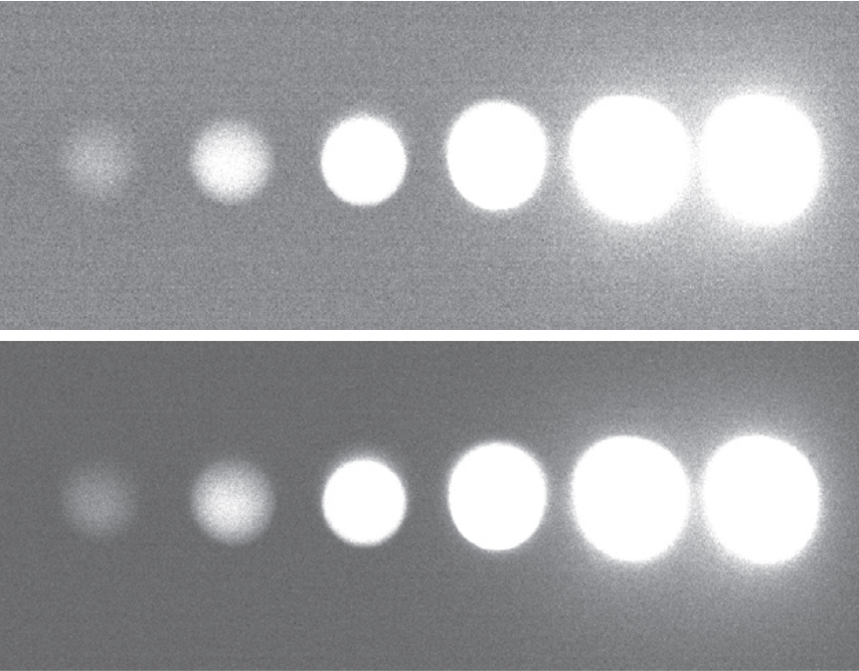Exclusive Product Features
Alongside Camera Basics and Advanced Imaging, there are also elements to scientific cameras that are exclusive to Teledyne Photometrics camera solutions. We offer a wide range of CCD, EMCCD, and CMOS cameras which all come packed with hardware and software solutions to real-life imaging pains, thanks to our time in the field and imaging labs talking to imaging experts and industry leaders.
These articles will detail exclusive product features for Teledyne Photometrics cameras, read on for more!


Programmable Scan Mode
Photoelectrons on a CMOS sensor are read out to a converter, producing a digital signal. This readout process can be controlled using Programmable Scan Mode, which can introduce delays, modify scan times and even change scan directions!
This mode pairs up well with strobing light sources, large sample sizes, and light-sheet microscopy, allowing for fine control over camera readout in order to minimize dark time and exposure while maintaining high speeds and efficient readouts!
Correlated Multi Sampling
Read noise can have a significant impact on quantitative scientific imaging, especially when imaging in low-light, at high speed, or with samples that have a low signal level. We minimize read noise across our camera range with CMS mode, to maximize sensitivity and allow for easy detection of ultra-low signals!
This article covers how CMS mode works, different implementations of CMS in different sensitivity modes, and how a sub-electron read noise can benefit your imaging!


SMART Streaming
With our advanced hardware triggering capabilities, including multiple expose-out triggering of up to four different sources, we can implement modes that allow for more control over multi-channel imaging, introducing variable exposures.
Sequenced Multiple Acquisition Real-Time Streaming, or SMART Streaming, lets users set individual exposure times for up to 16 different channels, resulting in much faster cycling than with software controls. Read on to find out more!
Citadel Chamber Design
Scientific camera sensors are highly complex, fragile, and susceptible to damage from dust or moisture. For this reason, sensors are housed in protective chambers, the better the chamber design, the better the cooling and longevity of the camera.
Teledyne Photometrics’ cooled cameras use Citadel chamber design technology to protect scientific camera sensors, which results in less than 0.1% chamber failure, and is a process that has been refined over 40 years. Read on about Citadel chambers in this article!

Prime 95B and Prime BSI Only
QuantView
Scientific cameras generate images in grey levels, to convert back to electrons it is necessary to know the bias level of the camera and the gain. Alternatively, you can use QuantView, a Prime camera family feature that instantly converts images back to electrons.
QuantView allows for easy quantitative comparisons of different cameras, or the same camera across different light levels or gain settings.


PrimeEnhance™
Computational imaging is a powerful tool in scientific imaging, and the Prime camera family comes packed with exclusive software to ease and improve quantitative scientific imaging, such as PrimeEnhance.
PrimeEnhance quantitatively increases the peak signal-to-noise ratio by reducing photon shot noise, increasing the clarity and quality of images. Read on to explore PrimeEnhance and how it can enhance your imaging!
Prime 95B Only
PrimeLocate™
Computational imaging is a powerful tool in scientific imaging, and the Prime camera family comes packed with exclusive software to ease and improve quantitative scientific imaging, such as PrimeLocate.
PrimeLocate dynamically evaluates acquired images and reduces the surplus of data generated during high-speed super-resolution imaging, well suited for localization microscopy (SMLM). Read on to explore PrimeLocate and how it can enhance your imaging!

Retiga E CMOS Family Only
Extended Dynamic Range
Dynamic Range is a factor of the upper signal limit of the camera, namely the full-well capacity, and the lower signal limit of the camera, namely the read noise. While different camera modes can improve full-well or read noise, they rarely can do both.
The new Extended Dynamic Range (EDR) mode for the Retiga E7 CMOS combines a large full well capacity with low read noise for a large increase in dynamic range, find out how in this article!

Retiga E7 CMOS Only

Hybrid Binning
The Retiga E7 CMOS camera has hybrid binning capabilities, combining the best of CCD and CMOS technologies. In this article we discuss binning, the benefits of binning, and how the hybrid binning of the Retiga E7 CMOS results in increases in both speed and signal-to-noise ratio (SNR), thanks to careful electronic design across the sensor.
While the effects of binning differ between CCD and CMOS, each affecting speed and sensitivity in a different manner, hybrid binning brings together the benefits of both modes to the Retiga E7 CMOS. Read on to see how it all works!
